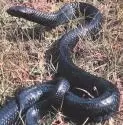If Winter Comes, Can Spring Be Far Behind?

We got a brief reminder this past weekend of what Spring will be like, and we drank it in deeply, like a silky glass of rich, red wine.
The sun came out, the thermometer flirted with fifty degrees, a flock of robins congregated in the hay field and the grass actually began to turn green. Our Winter here in the Blue Ridge Mountains surrounding Asheville has not been as traumatic as it has been for many of you, but we have difficulty dealing with what you would call ‘normal winter conditions.’
While we appreciate seeing the robins and the green shoots of grass, neither are a dependable sign of Spring’s victory over Winter’s despotic rule. For that, we have to wait for the return of one of our most misunderstood residents, the black snake.
I never knew much about black snakes until I moved into my seventies ranch house atop a wooded and rocky knoll. The house had been built into the southwest side of the knoll, requiring several stone retaining walls that, I soon discovered, made ideal dens for hibernating black snakes. The house had also remained vacant for several months before my arrival. That, along with a thriving population of field mice living in the untamed underbrush that constituted the yard, made it even more inviting for the snakes.
One March weekend, not long after the Arts & Crafts Conference, I came home to find not one, but five kinked black snakes warming themselves like semi-frozen garden hoses on my deck. They looked suspiciously at me as if I was the intruder, then returned to their sunning. I retreated, made a few frantic phone calls, did some quick research and discovered that black snakes are relatively harmless. They will bite if cornered and their bites can easily become infected, but they are such efficient hunters that they will rid their area of field mice and will convince their deadly cousins, the copperhead and the rattlesnake, to avoid their territory.
I was advised to allow a few of the black snakes to share the yard with me, but to learn how to safely relocate the majority of them. I soon began adept at firmly pinning their necks to the ground with a stick, then grasping them right behind the head. Needless to say, they never take kindly to my attack, and immediately wrap themselves around my arm and began imitating a boa constrictor. When that fails, they emit a musky scent that no fragrance company has ever deemed worth duplicating. I then walk them down to the creek or further into the woods before I release them.
One afternoon my then-young son called me from the driveway where he had spotted the tip of the tail of a black snake protruding from the end of a rotted railroad tie. Since it was only a few feet from the back door, I decided to move him to safer quarters. As my son watched in admiration, I grasped the snake by the tail and slowly began pulling him out into the open.
That was a mistake.
The tip of a snake’s tail is no indication of just how long and how large he might be. Or how mad he can get. We engaged in a slow dance. I applied pressure, he swelled in resistance, then, as he relaxed, I pulled a few more inches of him out of the timber. Had my son not been standing there, I would have let common sense prevail, but, instead, I continued coaxing the snake out of his den, even as he wrapped what soon became about three feet of his body around my right ankle and calf.
Black snake’s really don’t have much of a neck, so I was having a problem determining just when this long, angry black snake was going to whip out his head and lunge at me, as he had every right to do. I considered sending my son into the garage in search of a bucket, a rake, anything to give me the chance to make a graceful exit from the situation, but the pressure around my right leg led me to wonder if I hadn’t become the one being captured.
I had no choice but to do what common sense warmed me against doing. I stepped even closer to him and placed my right hand around his swelled body next to the railroad tie, as I continued pulling with my left. As much as I did not want to do it, I knew I had to grab his head the instant it popped free.
And I got lucky.
This snake was huge, almost six feet long, four feet of which was now firmly wrapped around my leg. But he was so large that I could actually feel his tapered neck and knew when to clamp down and get control of his head as it emerged from the hole, mad, mean and looking for someone to bite.
My son screamed and ran for the house, leaving me with the delicate task of unwinding this guy from around my leg without letting him squirm free from my now-weary right hand. He had no idea I meant him no harm and was convinced that, if he gave up the fight, he would become my dinner.
I must have walked a half a mile with him, not just because I had been told black snakes will return to their favorite dens, but because I wasn’t quite sure how I was going to fling six feet of heavy, angry black snake into the weeds without getting bit. Fortunately, the struggle finally wore him out and he relaxed enough for me to shake him loose from my arm as I flung him downhill, letting gravity help keep him from turning back on me.
It will be a few more weeks before the three or so black snakes that continue to hibernate in our stone walls emerge, but when they do, we’ll breath a sigh of relief that Winter has finally left. And when they do, trust me, I’ll not grab any of them by the tail.

Until next Monday,
Bruce
